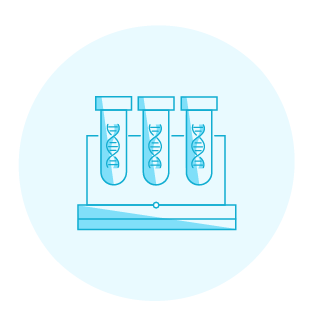What is Neurogenetics?

Neurogenetic disorders are prominently seen in clinical genetics practice and have increased notably with the advent of molecular approaches. Next-generation DNA sequencing techniques have made it possible to examine a large number of possible disease genes in a single reaction, which was impossible to do with previous methods. This has resulted in the rapid identification of genes involved in Mendelian disorders, thereby making a precise diagnosis of many neurological disorders possible. Genetic testing for the same can be considered in the early stages of the diagnostic procedure.
Prevalence
- Over 30 million people suffer from neurological disorders (excluding neuro infections and traumatic injuries) in India.
- Neurological disorders are often chronic, progressive, and debilitating, with phenotypes that are genetically heterogeneous.

What are the common Genetic Neurological Disorders (GND)?
- An estimate of 6 to 8 million people are diagnosed with epilepsy in India, with a prevalence of 5.7 per 1000 individuals
- Epileptic disorders are most prevalent in people at either end of the age spectrum (young and old)
- Epileptic disorders can be Syndromic or Non-Syndromic
- Some examples of epileptic disorders are: Benign Familial Infantile Seizures (BIFS) and Lennox-Gastaut Syndrome
- Neurocutaneous Disorders are neurological disorders that have cutaneous manifestations
- These lifelong conditions can cause tumors to grow inside the brain, spinal cord, organs, skin, and bones
- Examples of these disorders are: Tuberous Sclerosis (TS) and Neurofibromatosis (NF)
- Neuromuscular Disorders affect the peripheral nervous system
- These disorders affect the ability to perform voluntary movements
- Examples of these disorders are: Limb-Girdle Muscular Dystrophy, Spinal Muscular Atrophy, and Duchenne Muscular Dystrophy
- Neuro Degenerative Disorders involve a progressive loss of structure or function of neurons, including the death of neurons
- These disorders can be serious or life-threatening
- Examples of these disorders are: Adrenoleukodystrophy and Canavan Disease
- Neurological manifestations are the prominent signs and symptoms of inborn errors of metabolism
- Neuro Metabolic Disorders are characterized by the lack or dysfunction of an enzyme or vitamin necessary for a specific chemical reaction in the body
- These disorders are commonly seen in infants and newborn babies
- Examples of these disorders are: Maple Syrup Urine Disease, Neuronal ceroid Lipofuscinosis, and Krabbe Disease
- Movement Disorders are characterized by either excess or lack of movement that is not caused by weakness, paralysis, or spasticity of the muscles
- These disorders affect the speed, fluency, quality, and ease of movements
- Often associated with poor coordination of hands, speech, and eye movements
- The clinical presentation of these disorders is complex, often variable, and sometimes even bizarre
- Examples of these disorders are Spinocerebellar Ataxia, Tourette’s Syndrome, and Juvenile Parkinsonism
- Mitochondrial Disorders are a clinically heterogeneous group of genetic disorders arising due to mutations in mitochondrial DNA, or nuclear DNA coding for mitochondrial components
- These disorders are difficult to diagnose because they affect each individual differently
- Symptoms of mitochondrial disorders can include seizures, strokes, severe developmental delays, inability to walk, talk, see, and digest food, combined with a host of other complications
- Examples of these disorders are: Mitochondrial Myopathy and Myoclonic Epilepsy with Ragged Red Fibers (MERRF)
Why do you need to test for Genetic Neurological Diseases?

GNDs are relatively common in pediatric neurological practice, most of which have a Mendelian inheritance affecting the neurological system. GND can be accurately diagnosed through neuroimaging, biochemical assays, and genetic tests to help patients receive an accurate and actionable diagnosis.
When do you need to get tested for GND?
The four means to guide clinical classification in GNDs are:
- The earliest clinical signs referring to neuroanatomical changes or pathology specific to that disease
- The age of onset for the clinical signs and symptoms
- The mode of inheritance
- Other extra-neural signs and symptoms, such as the presence of specific signs involving the eyes, skin, connective tissues, or visceral organs, etc
Who needs to get tested?
- Individuals presenting with symptoms of neurological disease
- Individuals with family history of neurological disease
- Individuals without a family history or sporadic presentation with symptoms associated with a specific neurological disease
Why recommend Actia for patients with GND?
Actia offers a broad range of pre-designed gene mutation panels which have been developed with an in-depth understanding of the genetic disorder by incorporating the latest research in this domain. New and updated technologies, helpful customer service, and clear result interpretation along with counselling sessions with our expert genetic counsellors make us equipped to provide you the best available support for your patients and family members with GND
Actia Advantages
- Expertise in genetic testing with large in-house database
- High coverage with more than 22000 genes
- Dedicated in-house lab
- High throughput NGS machines
- Screening on world-class Illumina platform
- Best-in-class methods – NGS (X10, HiSeq, MiSeq) Sanger
GND panels offered by Actia
- Muscular dystrophy & congenital myopathy gene panel
- Comprehensive neurology panel
- Duchenne Muscular Dystrophy (DMD) deletion/duplication analysis
- Spinocerebellar ataxia repeat expansion analysis: SC A1, SC A2, SC A3, SC A6, SC A7, SCA10, SCA12
- Dravet syndrome (SCN1A) deletion/duplication analysis
- Tay-Sachs disease (HEXA) deletion/duplication analysis
- NeuroMit (whole mitochondrial genome sequencing & neurology gene panel)
- ExomeMit (whole mitochondrial genome sequencing & neurology gene panel)
- Dystonia gene panel
- Ataxia-telangiectasia (ATM) gene Panel
- NOTCH3 (CADASIL) gene panel
What are the test methodologies?
1. Next Generation Sequencing (NGS) Using genomic DNA extracted from blood, the coding regions of all the genes are captured and sequenced simultaneously by NGS technology on an Illumina platform. The sequence data that is generated is aligned and analyzed for sequence variants. 2. Multiplex ligation-dependent probe amplification (MLPA) Deletion and duplication analysis of genomic DNA is carried out by MLPA. This method allows for the amplification of multiple targets with only a single primer pair. 3. Fragment analysis PCR for repeat expansion analysis These rely on the detection of changes in the length of a specific DNA sequence to indicate the presence of repeat expansions.
Test sample requirements
 Blood (3-5ml in EDTA tubes)
Blood (3-5ml in EDTA tubes)
Required forms
- Relevant clinical information including all the clinical presentations and symptoms
- A Test request form
 Extracted DNA samples (1µg high-quality DNA)
Extracted DNA samples (1µg high-quality DNA)
FREE GENETIC COUNSELLING

Actia offers all your patients FREE pre and post-test genetic counselling with our expert and certified genetic counsellor. We provide the best available support for your patients and families with
- Latest technologies
- Helpful customer service
- Clear result interpretation
- Counselling sessions with our genetic counsellors


 Enquire
Now
Enquire
Now